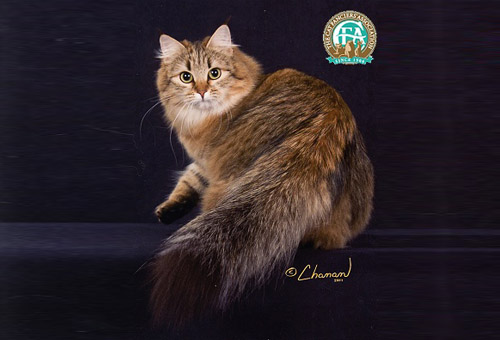

 |
GC, BW, RW KOTCHERA CREME BRULEE, Brown Mackerel Tabby Siberian Female Photo: © Chanan |
 Pictured: Second Best of Breed GC, RW SINEGLAZKA BUGSY, Seal Lynx Point Siberian Male Photo: © Chanan The Siberian tends to be both a great problem solver and also, rather like dogs, are loyal to their adopted families which is why they are so well suited to the households in which one spouse, usually a husband or significant other, professes to be a "dog person" not a "cat person." Often it is that same "dog person" who is greeted at the door by their Siberian and after being dutifully followed around the house by their Siberian, then decides that one Siberian is simply not enough!  Pictured: Third Best of Breed GC, RW MISHA ZEMCHUG NEVY OF SINEGLAZKA, Seal Lynx Point Siberian Male Photo: © Chanan Siberians are extremely agile and can leap great distances and heights to "fly through the air with the greatest of ease!" However, their agility also means they usually navigate potentially breakable brick-a-brac without leaving a path of destruction in their wake. Prudence dictates that one would still want to think twice about placing a Ming Dynasty vase on the mantle. A delightful combination of the flying Walenda's and the sleuth "the Pink Panther," the Siberian is a zany mixture of both. Expect the unexpected when sharing your home with a Siberian. Pricing on Siberians usually depends on type, applicable markings and bloodlines distinguished by Grand Champion (GC), National Regional winning parentage (NW or RW) or of Distinguished Merit parentage (DM). The DM title is achieved by the dam (mother) having produced five CFA grand champion/premier (alter) or DM offspring, or sire (father) having produced fifteen CFA grand champion/premier or DM offspring. Usually breeders make kittens available between twelve and sixteen weeks of age. After twelve weeks, kittens have had their basic inoculations and developed the physical and social stability needed for a new environment, showing, or being transported by air. Keeping such a rare treasure indoors, neutering or spaying and providing acceptable surfaces (e.g. scratching posts) for the natural behavior of scratching (CFA disapproves of declawing or tendonectomy surgery) are essential elements for maintaining a healthy, long and joyful life. There are CFA clubs devoted to the promotion, protection and preservation of the Siberian breed. For more information, please send inquiries to CFA at cfa@cfa.org. Last Updated: Sunday, July 04, 2010
|
|